
This page last modified: 30 July 2015 (Equites armigeri seniores Orientales entry added)

The following units are listed as being under the command of the Master of the Soldiers in the East (the numbers in front of the names refer to Ingo Maier's numbering scheme):
|
10 Vexillationes comitatenses: (see notes)
15.3 Comites catafractarii Bucellarii iuniores (see notes) |
Auxilia palatina: (see notes)
15.13 Felices Arcadiani seniores |
Legiones comitatenses:
15.16 Quinta Macedonica |
11 Pseudocomitatenses: (see notes)
15.26 Prima Armeniaca |
The Munich manuscript states - and lists - 10 vexillationes comitatenses, whereas the Paris manuscript says 11, while seemingly listing 10. In the Munich manuscript, the Comites catafractarii and Bucellarii iuniores are written as a single entry on a single line, whereas in the Paris manuscript, they are written partly as a single entry - they are capitalized as two entries, and are written on two lines, but the break occurs between iu and niores rather than Comites catafractarii and Bucellarii iuniores like might be expected of two items, and they are punctuated as a single entry (there is also a blank line left before the combined entry). Nonetheless, this seems the only reasonable place to break up an entry into two, if two are to be accounted for (and I would argue based on the names alone they should be, even without the evidence of textual confusion). Furthermore, the Froben edition (B) very clearly separates them as two different entries, albeit still saying there are 10 cavalry units, and not the 11 it clearly lists. According to Ingo Maier, who has inspected the various manuscripts personally, both the Bodleian manuscript (O) and the Vatican manuscript (V) declare 10 units, and put the line break between Bucellarii and iuniores; the Trento manuscript (T) also declares 10 units, while putting the line break in the same place as the Parisian manuscript, but having a period separating the two units in addition; while the London manuscript (L) derived from the same lost Basel manuscript as the Froben edition, declares 10 units, has the two on the same line, and has the two units clearly separated with a period. Incidentally, all the manuscripts (but not the printed Froben edition, B) actually have Butellarii: the appearance of a medieval manuscript "t" and "c" are very similar.
The two auxilia palatina units are not identified as such; this has to be inferred from their position in the list, coupled with the fact they have shields, and are thus not cavalry.
Regarding pseudocomitatenses units, M says there are 11 (while listing 10); P says 5 (while listing 10); while B alone states there are 10 and lists 10. Ingo Maier reports O also says 11, and so do T, V, and L.
Of all the commands listed in the Notitia, it is perhaps that of the Magister Militum per Orientem that has the greatest degree of "coordination" among its shield patterns; there are many that are similar to one or more other patterns in the same command (those of the Magister Militum Praesentalis I are also particularly well coordinated). This may well have something to do with how the command was formed; which was during Theodiosius' reign, shortly before the original Notitia was compiled. It appears that originally, the east, like the west, had just two Masters of Soldiers, but during Theodosius' reign, three more were added. The first of these appears to have been the Magister Militum per Thracias, whose shield patterns show a certain degree of coordination, but not a high degree, as there is evidence in the Notitia of units having been transferred out of that command since its formation.
The command of the Magister Militum per Orientem appears to have been formed later, after Theodosius turned his attention away from the Balkans to the east (this despite the Oriental command taking precedence in the Notitia over that of Thrace). The high degree of coordination here can be explained by there having been little time to transfer units in and out of the command in the time since it was formed and when the Notitia was compiled. It is notable that some of the units that do not shown coordination to units within the command do show coordination with units outside the command. The last command to have been formed appears to have been that of the Magister Militum per Illyricum; it bears the hallmarks of a recently-formed scratch force, as many of its units' patterns - those drawn from garrison units - are missing.
The shields of the 11 cavalry units are not illustrated. The shields of the 21 infantry units are illustrated below from top to bottom, left to right, in the order given above, using the Bodleian manuscript (O) pictures.
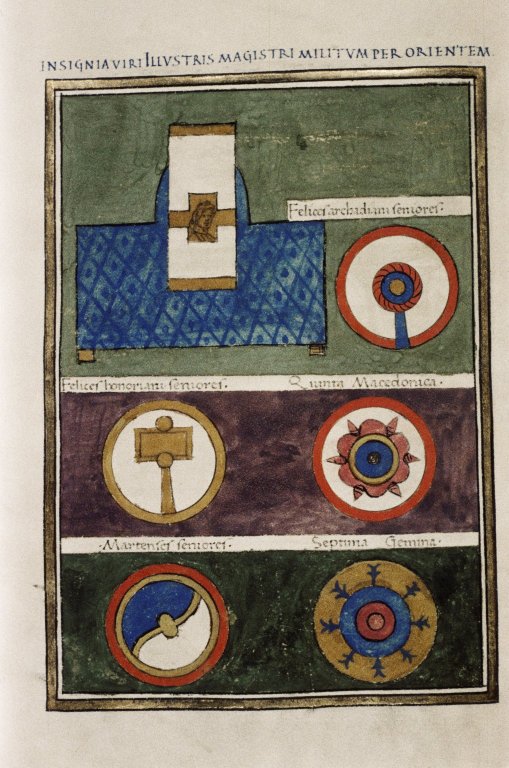
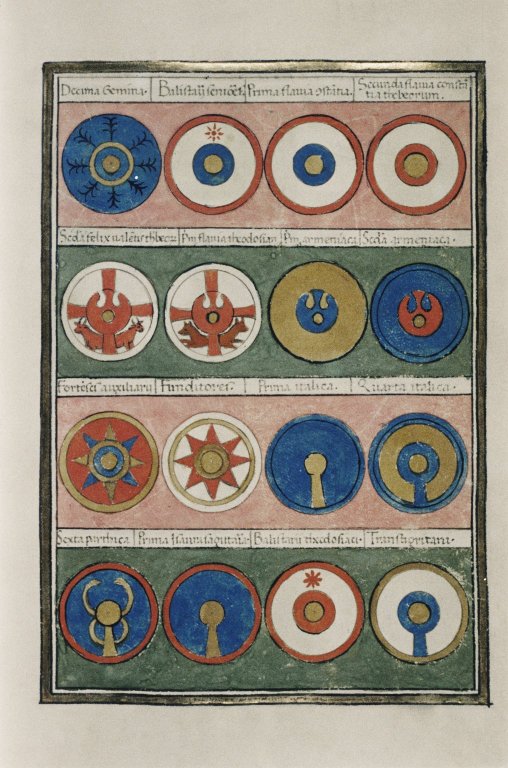
An inscription (AE 1907,62) from the Golden Gate in Istanbul (and thus dating to 413 at the earliest) giving (in a mixed Latin and Greek inscription) a [...]U[.]ERI MILITUM PRIMO SAGITARIO[.]UM LEONUM IUNIORUM has been taken (e.g. by by Roger Tomlin, Seniores-Iuniores in the Late-Roman Field Army (1972), at p 272, available here) as evidence for the western auxilia palatina unit called the Leones iuniores, but if so, the formulation is extremely unusual, since the primary part of the unit's name would be the "Primi sagitarii", which is not at all hinted at in the Notitia. Indeed, I would suggest this inscription (if it refers to any unit in the Notitia at all, which I doubt) might instead refer to the Equites primi sagittarii under the Magister Militum per Orientem. We know of at least one other cavalry unit bearing the name "Leones": the Leones clibanarii or Leontoclibanarii, attested from late 5th and 6th century Egyptian papyri. However, other interpretations are possible - see here , for example.
Below are the same units as illustrated in the Parisian manuscript (O).
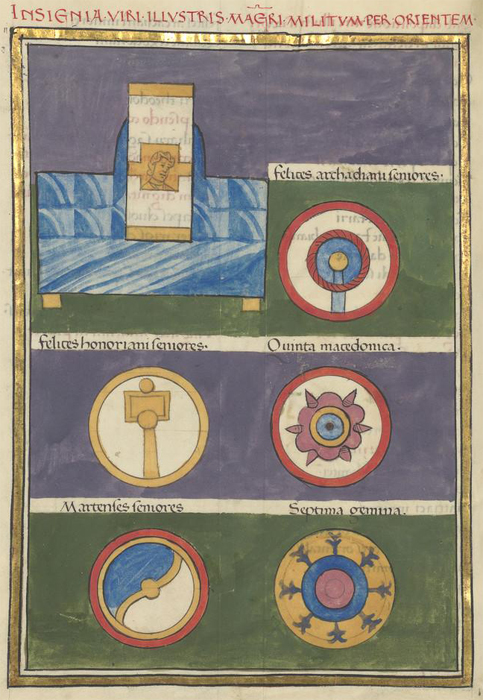
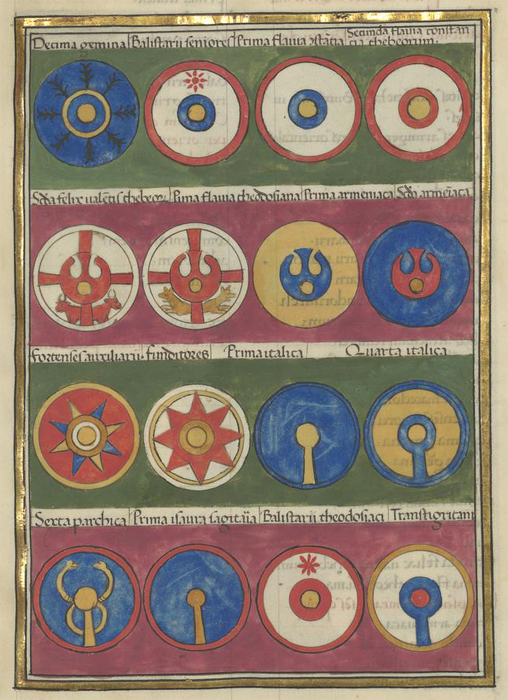
Below are the corresponding pictures from the Munich manuscript: first portion on top (M); second portion below (W).
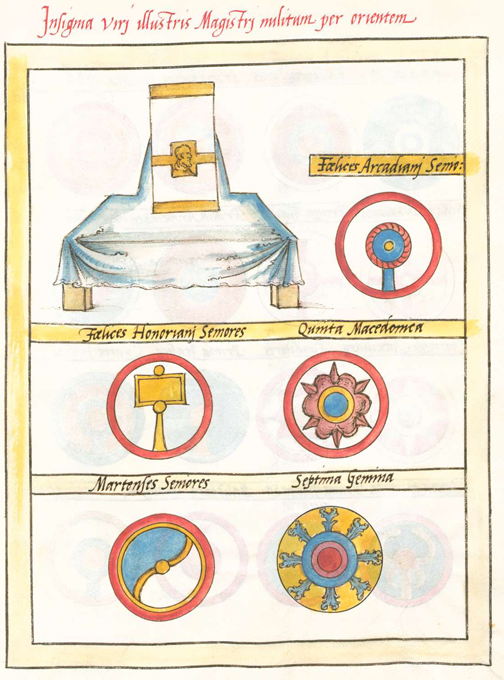
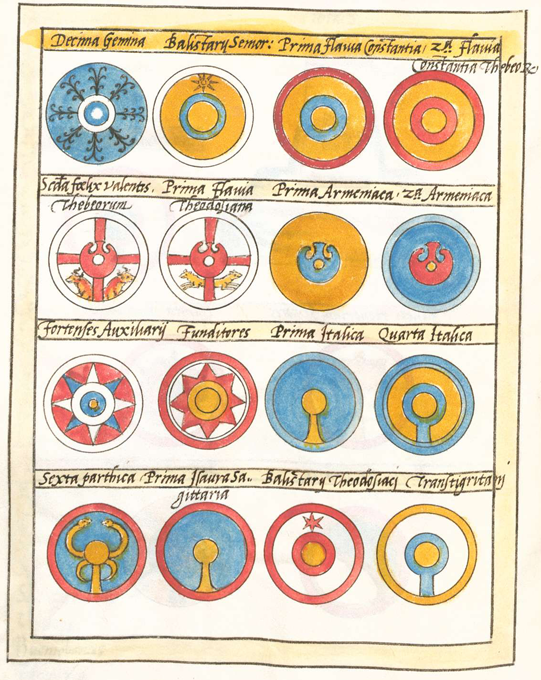
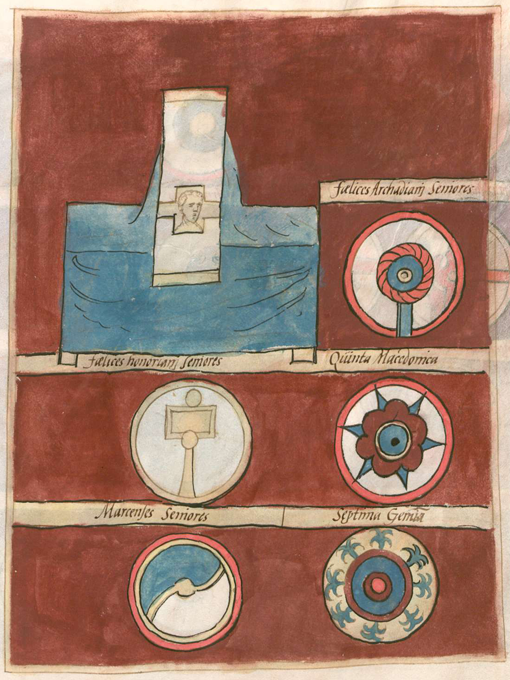
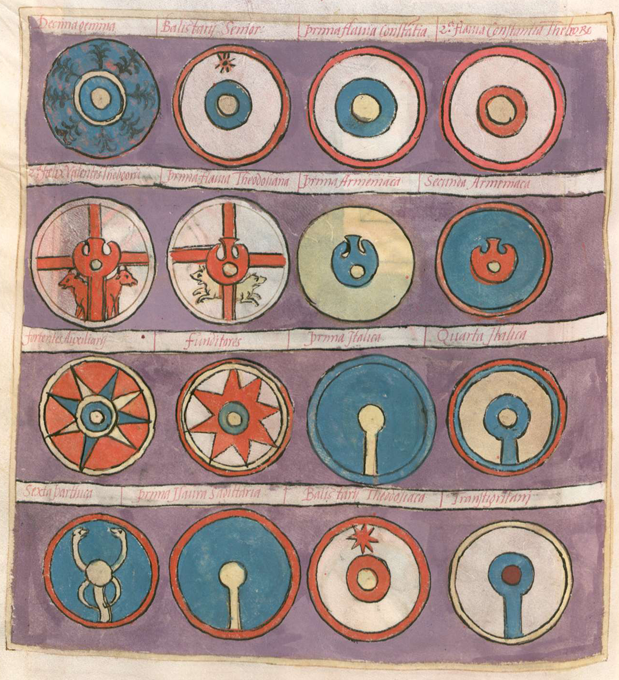
Below are the same patterns as illustrated in the Froben edition (B).
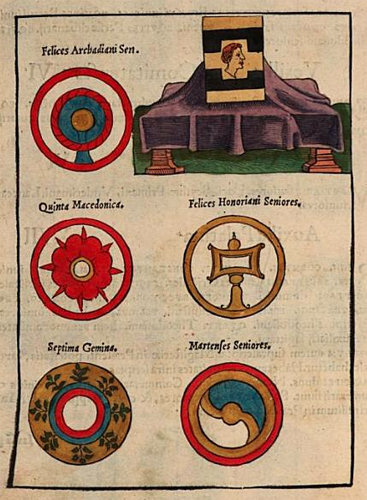
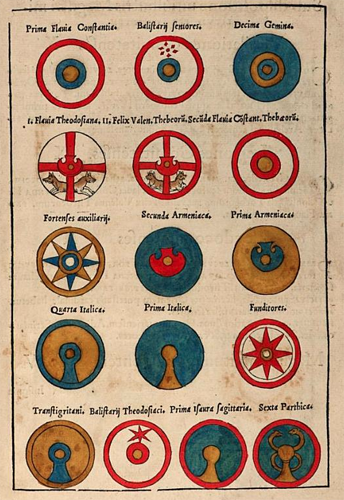
In addition to the units enumerated above, the Notitia gives the Magister's staff as follows:
15.37 A chief of staff (princeps)The Magister's staff are, like those of the Magister Militum Praesentalis II, said to be permanent; this differs from the staff of the Magister Militum Praesentalis I, the Magister Militum per Thracias, and the Magister Militum per Illyricum, whose staff are said to be drawn from those enrolled in their respective forces.
15.38 Two accountants (numerarii)
15.39 A custodian (commentariensis)
15.40 A chief assistant (adiutor)
15.41 Clerks (scriniarios)
15.42 Quartermasters (mensores)
15.43 Secretaries (exceptores) and other attendants (apparitores)

Return to the Notitia index page.